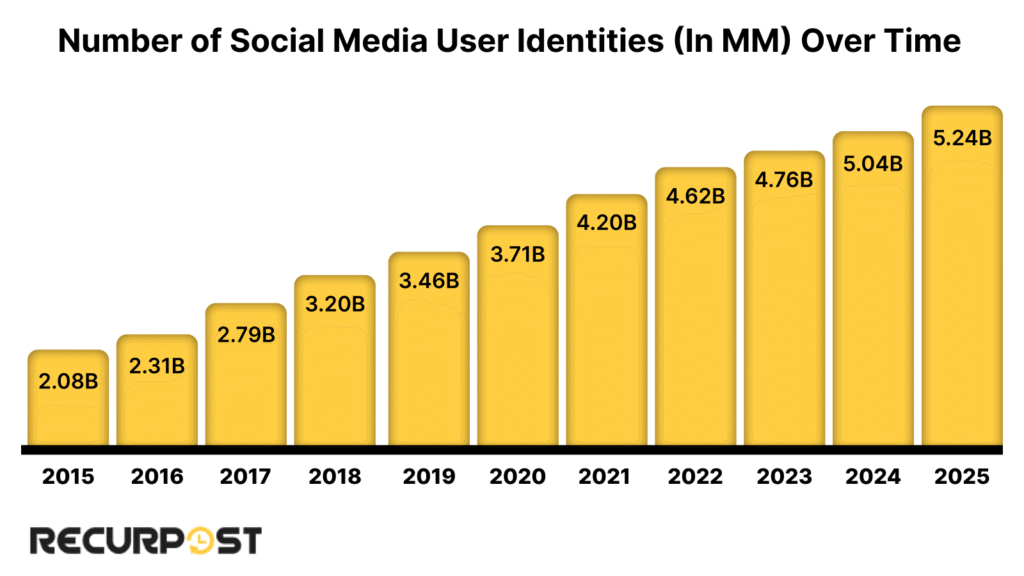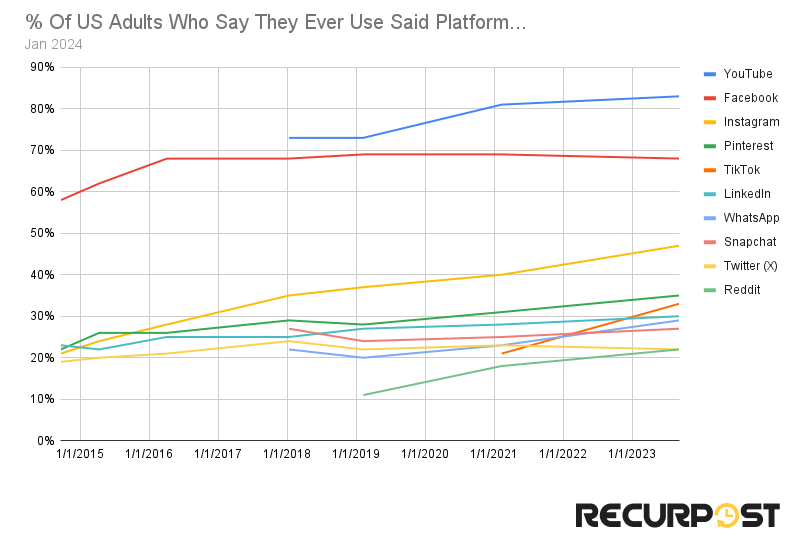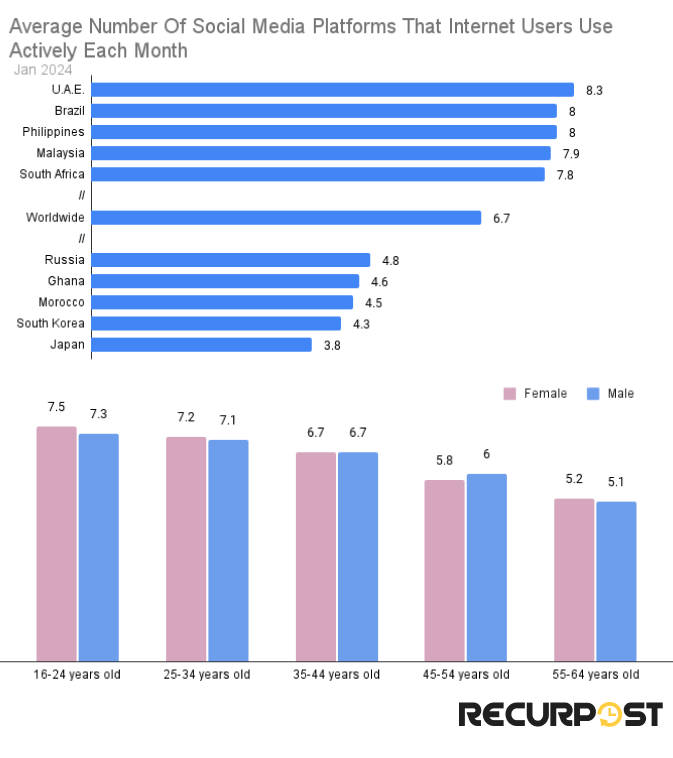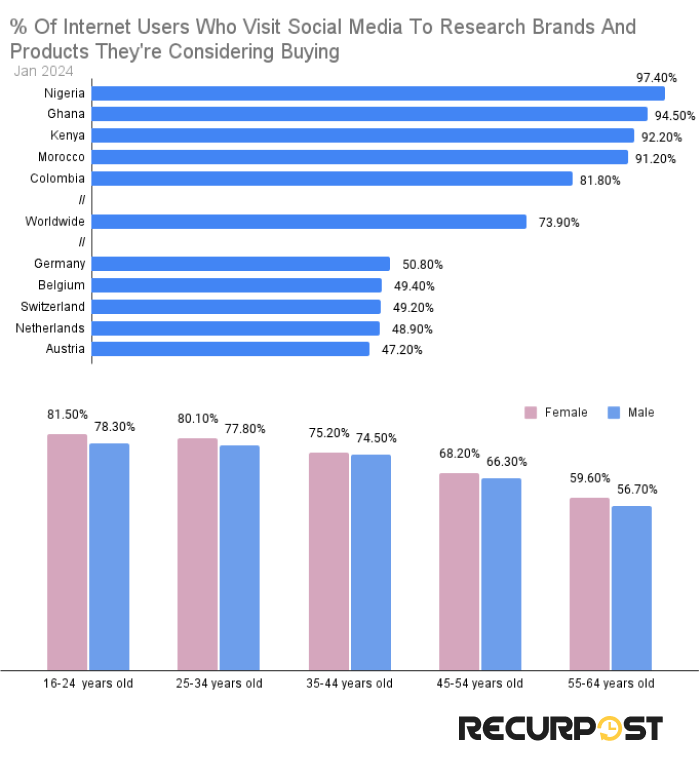The following article on social media statistics will help determine the audience demographics of all the major social platforms we know today. These include their content preferences, time spent, income group, and others.
We will look at how many social platforms people use on average and the time spent on them. Finally, how various nations differ in their use of social media and how people see it affecting the democracy of their country.
TL;DR
- Global reach: Over 5.2 billion social media user identities exist globally (~60% of the population; 94% of internet users).
- Platform demographics: Males slightly lead overall; teens heavily favor YouTube, TikTok, Snapchat, Instagram; adults skew toward YouTube & Facebook.
- Regional insights: Eastern Asia accounts for ~30% of users; Middle Africa the least; average person uses 6.7 platforms; UAE leads at ~8.3, Japan at ~3.8.
- Usage patterns: Global daily social time ~2h23m; Kenyans highest (~4h), Japanese lowest (<1h); WhatsApp sees ~930 monthly opens but short sessions; YouTube engagement ~7 min per session.
- Platform size & engagement: Facebook holds ~3 billion MAUs; TikTok in the billion‑club; YouTube has widest age/economic appeal; Instagram & Snapchat are Gen‑Z centric.
- Marketing & ads: ~74% globally research brands via social channels; Facebook drives over half of social‐referenced web traffic; social ads represent ~29% of digital ad spend at ~$6 CPM, with 24% YoY impression growth.
- Top creators: Forbes names top earners like MrBeast ($82M), KSI, Jake & Logan Paul, Charli D’Amelio—totaling 2.6 billion followers and ~$700M in earnings.
- Democracy impact: Developing countries (e.g., Nigeria, India) view social media positively for democracy (~77%); more cautious sentiment in EU/US.
What’s Trending in Social Media in America with New Shifts?
Users Demographics

Can you believe that around 60 percent of the world’s total population is on social media? This means of every five people you meet, three are on any of the social platforms. Although here identities do not mean individual users and the actual percentage might be a bit lower, still that too will be huge.
The same, when compared with internet users, comes at around 94 percent meaning that roughly 9 of 10 people in the world who use the internet are present on social media. Similarly, more than four-fifths of the adult population (18+) is on social media.
Gender

On a larger scale, males turn out to be leading the use of social media. However, the ratio varies notably when considering the demographics of each platform.
Also with the rise of individuals not finding their sexuality only in the two options, Pinterest started including an option of “unspecified” when asking its users about their gender. Discover how the demographics look for Pinterest from our Pinterest gender distribution article and also learn how Pins boast more half-life than any other social media posts.
Education, Income and Community
The following heat maps are based on a report by the Pew Research Center on the demographics of US Adults and Teens who use social media based on parameters such as community, income, education level, and others.
For Adults

The businessy-looking blue “in”, where the ties and suits gather. They swap business cards instead of memes—talk about serious networking!
For Teens

A comparison of the heat maps reveals that while the average interest of adults is mostly centered around two platforms, YouTube and Facebook, other platforms are catered to specific audiences.
As for teens, they share a love for four platforms (in a dark shade) namely YouTube (highest) followed by TikTok, Snapchat, and Instagram.
TikTok has especially created a place in the heart of US teens. When the wave of banning TikTok, partial and full, was high among countries like India, Afghanistan, Pakistan, and others, US teens strongly opposed the ban of TikTok.
US adults, based on their political inclination, have huge differences in how they view a ban on TikTok and it has even changed with time. View our infographic and learn more on the same from our TikTok statistics article.
Based On Region

Some regions have more social media users compared to others and there can be many reasons such as the overall population, ease of mobile and internet access as well as the level of government regulations.
As of April 2025, Southern Asia contributes the most to the global social media world, around 30 percent of users worldwide. Other regions of America, Europe, Asia, and Africa also provide a significant proportion of users.
Download the Ultimate 2025 Social Media Demographics & Usage Report (108-Page Free PDF)
🚀 Trusted by 5,000+ Marketers & Brands | 📥 Download Now – Free for Subscribers Only
More Than 5 Billion

With platforms like Hot or Not, Friendster, and Myspace in the early 2000s, there still were social media users; however, the momentum shifted after the launch of Facebook, YouTube, LinkedIn, and Twitter in the mid-2000s, and that’s when the stats in the above bar graph started showing dramatically taller pillars.
Instagram, Vine, Pinterest, and others also came in the early 2010s and that’s when social media user identities crossed the 1 billion benchmark. Today, there are more than 5 Billion social media users and platforms such as BeReal, Clubhouse, and others continue to launch.

Social media statistics by year show dramatic growth, with only 1 in 4 people using social media in January 2014, compared to roughly 6 out of 10 people today.
When going platform-wise, LinkedIn’s ad reach is at 12.7 percent of the world’s population. Learn other amusing facts about the professional platform including why it is the desired platform for marketers and how LinkedIn is working to make its workplace equitable for everyone from our LinkedIn workforce diversity article.
Comparison Of Social Platforms- Monthly Active Users

Facebook, said to be of a gone age, has still the largest active user figures and claims the top position here. TikTok is the youngest in the billion club and we are curious to watch how cleverly it climbs the step.
All, except Pinterest, here have more than 500 million active users which is enough to give us a glimpse of the hold these platforms have nowadays over our lives.
Note that users may not represent unique individuals.
Popularity Among US Adults

Among US adults, YouTube can be said as the most popular social platform with more than 80 percent agreeing to have used YouTube once. Facebook closely follows and if there is a doubt as to why FB with its billions of users isn’t top here, this can be understood with the help of the following chart.
A general upward trend, except for x (formerly Twitter), can be seen for all the platforms and if you are curious enough to know why the tweets (sorry posts) are not trending now, take a look at our X (Twitter) statistics article.
Youngest & Oldest Audience Difference

The largest gap between users is found in Instagram, Snapchat, and TikTok which are said to be GenZ platforms, and also over the years, they have tailored their features and UI in a way that suits better to tech-savvy youth.
Note that the larger the difference, the more that platform is limited to an audience of only one age group.
Here, Facebook has the lowest gap which explains why the platform has survived even when its early users have shifted to new age groups. More details and facts on the platform are explained in our Facebook statistics article.
Comparing Countries

When examining social media usage differences between young and old adults, Poland shows the largest gap with a difference of 50 points. Four other countries—Germany, Indonesia, Hungary, and India—stand out for having gaps of 40 points or more.
Israel has the lowest difference at 13 which allows us to conclude that all nations in this list have a difference of more than 10 points. The age gap in the use of social media has narrowed with time.
Number Of Social Platforms Used By Users

Social media usage statistics reveal that with so many platforms offering unique perks, people are bound to be present on more than one app. However, users in some countries engage with more social apps compared to others.
Users of UAE use roughly 8.3 social apps, the highest, and those of Japan just 3.8, the lowest. On average in the world, people are present on 6.7 platforms.
When compared based on age and gender, the young audience is present on most social apps compared to older adults and in all age groups, females seem to have an edge over males.
Learn more about social media audience overlap and why it is important for marketers from our Instagram statistics article.
App Sessions

People open WhatsApp around 930 times on average in a month, which is more than 2.5 times than LINE, the second on this list.
Other social platforms are way behind WhatsApp in the race however, why they need not worry will be clear when we look at the next infographic.

Although people may be opening WhatsApp too often, they just spend a little more than a minute during each session. The same can be seen for all the instant messaging apps.
It is YouTube and other video-centered platforms, where people are most engaged. Once they click that red play button, users stay on YouTube for around 7 minutes on average.
Also, learn about how YouTube held the crown for 12 months for being the top streaming platform by watchtime in our YouTube time spent article.
Time Spent On Social Media
Each day

As shown in the social media statistics graph above, internet users spend around 2 and a half hours on social media each day. Time spent varies greatly, with Kenyans spending the most (close to four hours) and Japanese the least (less than an hour).
Social media usage by age shows that those aged 16-24 collectively spend more time on these platforms than any other demographic. Additionally, females spend nearly 10 minutes more on social platforms compared to males of the same age group.
Wanna know on which social media platform US adults spent the most and least time in 2023? Slide over to our Instagram statistics article and also learn how Instagram is taking measures to protect its community from content that violates its community guidelines.
As A % Of Total Internet Time

Worldwide, if people are using the internet for an hour, they are on social media for around 22 minutes. And surprisingly even South Korea and Japan, the countries lowest on this list, spend around 13 minutes of their 1 hour use of the internet on social media. Saudi Arabia, the top on the list, is on social media for 26 minutes for an hour’s use of the internet.
Similar to trends observed in the above charts, it is the females that outperform males, and that too significantly.
Among Different App Categories

Social media apps are doing well in terms of engaging people and eating their time, compared to other apps. If Peter is to spend 1 hour on his Android phone, almost 21 minutes are spent scrolling social feeds, another 18 for entertainment, and the rest for other purposes.
This pie chart’s a snapshot of our phone’s diet: mostly social media snacks with a side of binge-watching. Productivity apps are the veggies we promise to eat, but end up pushing aside. And games? Well, they’re the weekend cheat treat we can’t resist!
Internet vs. Social Media Use

Moving on, if we look at the difference in the percentage of people who use the internet but not social media, we find Germany on top of the list.
This is surprising because it is not that Germany, Netherlands, France, or others do not have access to the internet. Rather they are better to do than Kenya or Nigeria, which are on the bottom list, however, people like to do other things than use social media.
To sum up, a person with internet access is more likely to open social media sites in Nigeria than in Germany.
What Users Love On Social Media..
Preferred Activity

Each social platform has its unique features by which they try to grab user attention and users too prefer different platforms for specific activities.
Facebook is the preferred one for keeping in touch with our loved ones, whereas Instagram and Snapchat stand out for allowing people to express themselves by posting or sharing content.
Although TikTok is the go-to platform for finding funny or entertaining content, the news-consuming pattern over the platform has increased significantly over the years. Learn more about news consumption on TikTok from our TikTok preferred content article.
Preferred Content

The heat map above shows the preferred content that users want on different social platforms. If we observe, we find that it’s YouTube that covers most of the interests of people, and it is rightly said to be the world’s second-largest search engine, after Google of course.
Moreover, 78% of users believe that it helps them to keep up with the industry news when they consume professional content on LinkedIn. The content consumed also varies greatly with each generation on LinkedIn. Curious !! Learn about the same from our LinkedIn statistics article.
Brands Seeking And Research

When it comes to discovering and learning about brands, social media has changed the traditional way. Now, users see ads of brands, relevant to their needs, popping up during their session on screens and they find themselves helpless not to click on them.
However, some countries are ahead of others in this regard. We find Brazil as the front-runner where more than half of users are learning about brands through their social media handles.

While discovering brands is happening a lot on social media, researching a brand from which we are considering buying products is happening more rigorously with the global average being around 74 percent.
While African individuals lean heavily on social media, Europeans tend to be a little conservative, but still, around half of users consider it a ritual to visit the brand’s social media page.
Although people still depend on search engines to learn and research brands, the curve changes for different age groups. We compared the use of social media and search engines for shopping decisions and the results turned out quite interesting.
Web Traffic To Third-Party Websites

Facebook accounts for more than half of the traffic, from social media, coming to third-party websites. Well, it is no surprise considering Facebook’s age. Although YouTube and LinkedIn are considered more popular than Pinterest, the virtual board platform is ahead of several other platforms.
Social Media Ad Revenue



The total digital ad spending in 2023 was at $601.84 Billion and projected to hit $667.58 Billion by 2024, according to eMarketer. Although digital ads include several forms like audio, search, display ads, and others, social media ads contribute a significant percentage of the total revenue.
In 2023 the share stood at around 29%, experiencing a slight dip from previous years. Similarly, what marketers paid for 1000 ad impressions to social media giants stood at $6.06 at the end of Q4 2023, slightly lower than what it was a year before.
However, ad impressions saw a significant growth with 2023 ending with 24 percent more impressions than a year before in Q4 22. Engagement benchmarks, on the other hand, saw a decline for all platforms except for Facebook. Learn more about the same and how the activity is dropping significantly on X from our X (Twitter) engagement article.
Top Creators
| Name | Earnings | Total Followers | Avg. Engagement |
| Jimmy Donaldson (Mr Beast) | $82M | 312M | 9.80% |
| Olajide Olatunji (KSI) | $24M | 112M | 6.50% |
| Jake Paul | $34M | 66M | 1.60% |
| Rhett & Link | $35M | 51M | 0.85% |
| Charli D’Amelio | $23M | 213M | 0.70% |
| Logan Paul | $21M | 74M | 1.25% |
| Elliot Tebele (F*ckJerry) | $30M | 17M | 1% |
| Emma Chamberlain | $20M | 28M | 6.25% |
| Matt Rife | $25M | 22M | 10.70% |
| Brent Rivera | $17.5M | 96M | 11.25% |
In their second annual report, Forbes released a list of the most influential social media out there who combinedly have 2.6 Billion followers and generated a wealth of 700 Million in 2023.
From MrBeast, and Charli D’Amelio to Khaby Lame, the list includes all those who made an impact through their talent and videos in the social media domain. Want to know about what’s top on YouTube including top channels and all-time most viewed videos? Head over to our YouTube statistics article for these and other interesting facts.
Digital Property

Instant messaging and social networks are the top digital properties that around 95% of internet users have either visited or used.
Other prominent ones include search engines, shopping-related properties, navigation, and mail, which more than half of internet users agree to use. There are some specific activities like Investing, Sports, and Games, which have their fan base as well.
Reasons For Using Social Media

While it is not wrong to say that social media has made the world a village where from the village elder to the notorious child, all our just a tap away. Thus, the primary reason for using social media remains to keep in touch with family and friends.
Users also head over to the scrolling feed to fill their spare time, read news, and know the current direction of the wind. A study revealed that the use of Pinterest for 10 minutes had a positive impact on users and they felt inspired along with increased levels of social well-being. Read about the experiment and its results from our Pinterest statistics article.
Democracy

Users are divided in responding to how social media has affected their countries. Some, such as Nigeria, Mexico, Singapore, and India have as high as 77 % of users saying that democracy is a good thing for their country.
While mostly European and UCAN users believe that social media is a bad thing for democracy. We can also relate this to the control the government has over social media platforms in different countries.
Where the laws are liberal, users are free to express themselves and consider it good, whereas the EU and US have pretty strict laws related to social media, and the same is reflected in the above chart.
Interestingly, the attitude of Americans regarding X (Twitter) and its impact on democracy differs largely based on their political inclination and this has changed significantly after Elon Musk took over Twitter. Read more on the same and how Americans are skeptical of X after its rebranding from our X (Twitter) and democracy article.
Developing nations are toasting to social media as democracy’s seasoning, while developed countries send it back to the kitchen. It’s a global feast with mixed reviews on the menu’s special: freedom of speech.
Conclusion
The user base of YouTube belongs to all age groups and economic and social classes, and the bright-red play button has brought everyone together.
Teenagers are more active on social platforms compared to their parents (and their parents also), and all are trying hard to capture their attention and time. If you’re looking to get popular on social media, understanding this dynamic is key to crafting content that resonates with younger audiences.
Instagram and Snapchat have the most difference in the age group of their user-base suggesting that these platforms have failed to capture the attention of the older adults. Moreover, users are not limited to just a few social platforms and are present on many simultaneously, making social media marketing statistics vital for businesses.
Funny and informative are evergreen content as almost everyone loves them and is sure to perform better than other content types. And people have made millions of dollars from social media.
You may also read: Social Media Engagement Metrics
Frequently Asked Questions
How many social media users are there in the world now?
As of January 2025, there are more than 5.22 Billion social media user identities in the world.
Which is the largest social media platform?
Based on monthly active users (MAUs), Facebook is the largest social platform boasting more than 3 Billion active users.
How much time people spend on social media?
Although time spent varies by country, globally people spend around 2 hours and 23 minutes on average on social media every day.
How much Mr Beast earned from social media in 2023 ?
Mr Beast aka Jimmy Donaldson earned approximately $82 M in 2023 according to Forbes.
How many social platform are internet users active each month?
On an average, internet users all over the world are present on 6.7 platforms.
Sources
1, 2 Digital 2024 – We Are Social USA Pg 206
3 Demographics of Social Media Users and Adoption in the United States | Pew Research Center
4 Social media use among US teens, by demographic traits | Pew Research Center
5,6,7,8 Digital 2024 – We Are Social USA Pg 212, 207, 210. 232
9, 10 How Americans Use Social Media | Pew Research Center
11 Younger people are more likely to use social media in most countries surveyed | Pew Research Center
12 Digital 2024 – We Are Social USA Pg 233 and 234
13,14 Digital 2024 – We Are Social USA Pg 240, 241
15 Digital 2024 – We Are Social USA Pg 227 and 228
16 Digital 2024 – We Are Social USA Pg 230 and 231
17 Digital 2024 – We Are Social USA Pg 420
18 Social media use is comparatively low in Germany | Pew Research Center
19 Digital 2024 – We Are Social USA Pg 242
20 HubSpot | Software, Tools, Resources for Your Business
21 Digital 2024 – We Are Social USA Pg 244 and 245
22 Digital 2024 – We Are Social USA Pg 247 and 248
23 Digital 2024 – We Are Social USA Pg 254
24, 25, 26, 27, 28 Digital 2024 – We Are Social USA Pg 535, 538, 537, 55, 221,

Debbie Moran is a Digital marketing strategist with 5+ years of experience producing advertising for brands and helping leaders showcase their brand to the correct audience. She has been a part of RecurPost since 2019 and handles all the activities required to grow our brand’s online presence.
